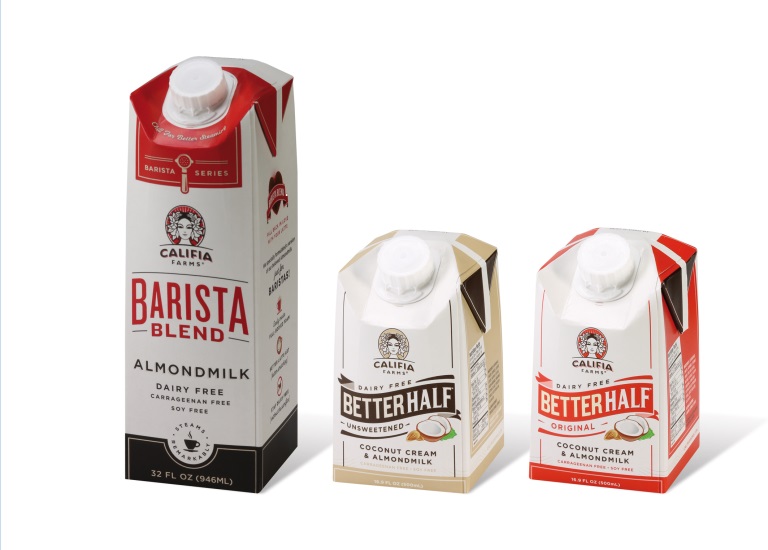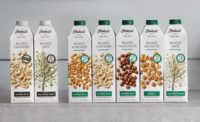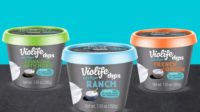New package formats
Plant-based beverages: from milk substitute to lifestyle product

Submitted by SIG Combibloc
They are the new stars of the beverage industry: plant-based beverages. The growth rate is continuing to climb, with experts predicting an increase of 15% per annum by 2020 – particularly due to the momentum in regions such as North America, Brazil, China and Thailand. But South Africa and various European countries are also key contributors to the significant growth in the segment of non-dairy beverages derived from plants.Market experts attribute this positive trend primarily to the fact that the image and product positioning of dairy alternatives has changed considerably in recent years – and with it the consumption behavior of consumers.
“Plant-based beverages are no longer seen as purely substitutes or alternative products which people resort to if they are lactose-intolerant, for instance. In many parts of the world, beverages made from nuts, grains, seeds or ancient grain varieties such as quinoa, buckwheat or millet have now become lifestyle products which people drink even when there is no compelling health reason to do so. Plant-based beverages are no longer niche products – instead, they are gaining popularity with an ever-growing target group,” says Matthias Krusche, global product manager at SIG Combibloc.
For people whose lifestyle choices focus on their own good health and making responsible purchase decisions, plant proteins are increasingly finding their way onto the menu. For one thing, they have health benefits for the organism: plant-based beverages are naturally lactose-free and are generally lower in cholesterol and fat than milk from animals. But they usually have a similar protein, mineral and vitamin content, and are easier to digest than dairy products. Because of their resource efficiency they also perform well in environmental aspects. When selecting these products, the origin of the ingredients, the growing and processing methods and often also the packaging are important considerations for consumers.
Some of the countries that already have a high per capita consumption of plant-based beverages are Thailand (2015: 11.1 l), China (5.6 l), Taiwan (5.0 l), Spain (4.7 l), Malaysia (4.4 l), Australia (3.9 l) and the USA (3.0 l). Particularly in Asia and various countries in the southern hemisphere, plant-based beverages are an integral part of the diet. Levels of lactose intolerance among adults are comparatively high in those regions. From an anthropological viewpoint, however, the inability to digest lactose is the norm in adults. Originally, only infants and toddlers could produce the lactase enzyme with which the milk sugar lactose can be broken down and then digested. As we grow to adulthood, our lactase production normally decreases. Due to a genetic shift, however, many people in the northern hemisphere can now also digest lactose in adulthood without problems. As a result of this genetic modification, lactase activity is retained even in adults. The genetic shift occurred in parallel with the domestication of cattle, goats and sheep as domestic and breeding animals whose milk has since then increasingly been used as a food source. Accordingly, these regions have become very strong, stable milk-producing nations – but in many areas, the markets are saturated.
Demand is growing
However, the growth of plant-based beverages is another story.
“Whether it is for health, environmental or ethical reasons, or due to an interest in alternative types of food – more and more people are making plant-based and dairy-free foods and drinks part of their diet. Demand has been increasing for years, and will continue to grow. According to forecasts, the countries that already have a high level of consumption of plant-based beverages will continue to lead in 2020 in terms of per capita consumption. Up to 2020, the strongest growth in consumption will be in South Africa (25%), Hungary (15%), China (14%), Ireland (12%) and Austria (12%),” says Krusche.
Looking at the development of individual products within the segment, soy drinks are no longer the sole drivers of growth. In 2010, soy drinks still had a global market share of 54% in the dairy alternatives segment, but the trend has since declined significantly. The market share was 34% in 2015, and according to forecasts these products will account for just 23% of the market by 2020. The main winners, on the other hand, are nut-based beverages and drinks made from ancient grains.
“Soy beverages are high in protein and vitamins, cholesterol-free, and lower in fat and calories than animal milk products. But they continue to divide opinion. For one thing, they have allergens which give some consumers intolerance reactions. For another, consumers are concerned about eating genetically modified soy, or ingesting too many of the phytoestrogens in soy, which could have a negative effect on the body. Reservations of this sort favor the growth in popularity of other plant-based, non-dairy drinks. Their market share is expected to be around 77% in 2020,” says Krusche.
According to Krusche, beverage manufacturers have great prospects for growth if they incorporate new trend varieties into their product portfolios at an early stage. In the area of nut-based beverages, alongside the already popular almond drinks varieties such as cashew and macadamia have good potential for growth. Compared to other types of nut, they are considered to have a stronger flavor. In addition, beverages produced from these nuts have a particularly creamy texture. In the area of grain drinks, experts say that in the future, in addition to oat drinks it will be varieties such as hemp or millet that have a positive impact on the market. Innovative beverages such as lupin drinks, made from the seeds of the Sweet Lupin, are creating a stir. These plants have a high protein content and are much lower in fat than soy beans. They are also free of starch, cholesterol and gluten. Their allergy potential is minimal.
Less water and lower CO2 emissions
For consumers who turn their attention to responsible consumption, ecological considerations often count in favor of drinking plant-based beverages. A number of beverage manufacturers have used calculations to show that the product life-cycles of vegetarian drinks pollute the planet less than that of a classic milk drink. For instance, much less water is used in the product life-cycle of vegetarian dairy alternatives than for the manufacture and processing of animal milk products. Similarly, the emission of greenhouse gases is substantially lower with vegetarian drinks.
“In this context, carton packs are the logical and coherent packaging solution for vegetarian drinks. They are designed to be resource-efficient and are composed up to 75% of wood, a renewable resource. In various independent and critically verified life-cycle assessments, carton packs have been environmentally rated in comparison to alternative packaging solutions. These assessments have shown that in every market segment in which they are used, carton packs have a significantly better environmental performance than competing packaging. So they fit perfectly with the business philosophy of food manufacturers who make naturalness and the responsible use of resources core themes of their organization. Against this backdrop, we are anticipating continuing strong growth of carton packs in the area of plant-based beverages. With the exception of Asia, they are already the leading packaging solution in this segment world-wide. And we are confident that this trend will continue,” says Matthias Krusche.
SIG Combibloc (sig.biz)is one of the world’s leading system suppliers of carton packaging and filling machines for beverages and food. In 2015 the company achieved a turnover of 1,720 million Euro with around 5,000 employees in more than 40 countries.
Looking for a reprint of this article?
From high-res PDFs to custom plaques, order your copy today!






